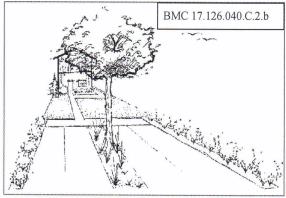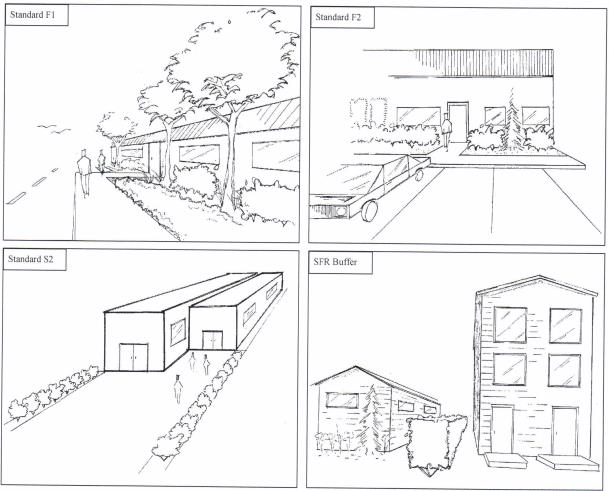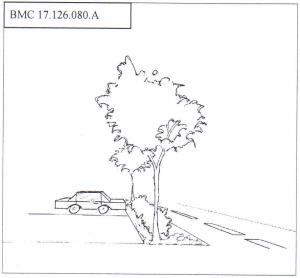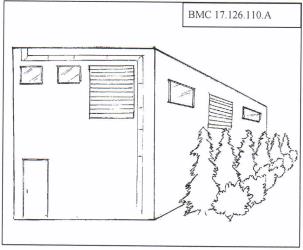Chapter 17.126
LANDSCAPING*
Sections:
17.126.020 Application of chapter.
17.126.030 Submittal requirements.
17.126.040 Landscaping guidelines in the central business district.
17.126.050 Development landscaping requirements.
17.126.060 Landscaping standards.
17.126.070 Landscaping installation.
17.126.080 Parking lot landscaping requirements.
17.126.090 Refuse areas and utility boxes screening.
17.126.100 Sight obstructions.
17.126.110 Zoning boundary screening requirements.
17.126.120 Change of use landscaping requirements.
17.126.130 Native landscaping requirements.
17.126.150 Maintenance requirements.
17.126.160 Completion of landscaping.
* Prior legislation: Ords. 2554 and 2673.
17.126.010 Purpose.
A. Enhance the community’s aesthetic character, and reinforce the coastal and nautical identity of the community;
B. Ensure high quality landscaping is utilized throughout the city;
C. Reduce negative impacts between incompatible uses and districts, especially the impacts on single-family residential uses and districts;
D. Ensure quality development;
E. Encourage citizens to participate in rejuvenating the city’s appearance;
F. Provide and maintain natural riparian corridors along streams, wetlands and drainage areas;
G. Provide visual screening for necessary and sometimes unsightly elements such as trash and utility facilities. (Ord. 2805 § 2 (Exh. A), 2011)
17.126.020 Application of chapter.
This chapter will apply to development that meets the following:
A. Any permit to construct a multifamily dwelling containing more than two units, or any commercial or manufacturing development;
B. A change of occupancy of commercial and/or manufacturing use property as defined by the International Building Code, and/or improvement which exceeds 30 percent of the appraised value of the existing structure(s) within any 12-month period. (Ord. 2805 § 2 (Exh. A), 2011)
17.126.030 Submittal requirements.
Landscaping plans shall be consistent with an approved site plan review permit and shall include the following information. The administrator may waive one or more of these requirements:
A. Professional Quality. The landscape plan shall be designed by a landscape architect, Washington-certified nurseryman/landscaper or other qualified landscape designer as authorized by the city, signed by the party accepting responsibility and liability for the proposed plan, and be submitted to the community development services.
B. Planting Map. The landscaping plan shall include a planting map that indicates common names, quantities, sizes at planting, and spacing for all plants. The map will show individual trees and shrubs. Ground cover may be expressed as on-center (o.c.) placement. Existing trees and vegetation that is to be retained shall be clearly indicated. Plant installation details and soil preparation procedures shall be included on the planting map.
C. Irrigation. An irrigation plan prepared by a certified irrigation designer, or other qualified irrigation designer as approved by the city. The irrigation plan shall include the following:
1. Location and size of separate water meters for the landscape, if required by the design of the irrigation plan. A separate water meter is not required per this section, but the irrigation plan and any installed meters must meet the minimum utility requirements;
2. Location, type and size of all required components of the irrigation system, including point(s) of connection, master control valve, automatic controllers, main and lateral lines, valves, sprinkler heads, moisture sensing devices, rain switches, quick couplers, backflow prevention devices and pressure reducing valves.
D. Grading Details. If land contours are to be altered, existing and proposed grading contours with spot elevations shall be drawn to scale on the approved site plan or landscape plan. All landscaped retaining walls, mounds and gullies are to be shown. (Ord. 2805 § 2 (Exh. A), 2011)
17.126.040 Landscaping guidelines in the central business district.
The central business district is divided into five subzones. The application of this chapter varies between the subzones to meet the goals of this chapter.
A. The market, waterview and town portal districts are intended to be a dynamic environment where pedestrians interact with buildings at the sidewalk. The city maintains street trees, hanging baskets and landscaping islands which enhance the aesthetic character of downtown. Throughout the districts buildings are encouraged to be constructed at the property line leaving no room for standard landscaping. The following are the landscaping guidelines for development in these districts:
1. All building construction projects are encouraged to utilize high quality landscaping in a creative manner such as installing window boxes, wall planters or hanging pots.
2. Areas not utilized by buildings, parking, travel ways or other elements required as part of a site plan review application shall be landscaped. The intent of this regulation is to avoid remnant areas that appear vacant or unmaintained.
3. Parking lots shall be landscaped pursuant to BMC 17.126.080.
4. Refuse areas and utility boxes shall be screened pursuant to BMC 17.126.090.
B. The wharf district is where commercial, industrial and recreational uses come together on the public waterfront. Landscaping in this district should be consistent with the intent of this chapter and Chapter 17.23 BMC, CB – Wharf Zoning District, Chapter 17.119 BMC, Wharf Zoning District Design Standards, and the 2007 Wharf Master Plan. Landscaping themes that reflect the maritime seaside are preferred.
C. The garden district is intended to minimize the conflict that inherently exists between highly trafficked commercial areas and quiet residential neighborhoods. Third Street provides separation between the CB-G district and SF-1 district; however, east of 3rd only an alley separates the two districts. For this reason, two different standards are applied to the CB-G district.
1. West of 3rd Street.
a. All building construction projects are encouraged to utilize window boxes, wall planters or hanging pots.
b. Front yards shall be landscaped from the property line to the front of the building, with the exception of walkways, patios, signage and fencing. A combination of trees, shrubs, and ground cover shall be used.
c. Side yards shall have a five-foot landscaping area. Sidewalks may encroach into this landscaping area but the landscaping area shall not be reduced to less than two feet in depth.
d. Rear yards shall include a five-foot landscaping area located at the rear property line. If parking is proposed directly off an alley, the five-foot landscaping area shall be maintained for at least 20 percent of the property width.
2. East of 3rd Street.
a. Front and side yard landscaping requirements shall be as defined for west of 3rd Street.
b. If parking is proposed directly off the alley, every two parking stalls shall be separated by a five-foot-wide landscaping island with a shade tree.

c. Parking areas shall be separated from side property lines by a minimum three-foot landscaping area. Grass sod or lawn is not acceptable for this parking area. Shrubs shall be of a species that grows to at least 32 inches upon maturity.
d. On-site parking lots accessed from a travel lane shall be separated from the alley by a 10-foot landscaping area consisting of small trees and large shrubs that average six feet in height at time of installation. The intent of this condition is to create a visual screen for the residential property across the alley.
e. If parking is not proposed directly off the alley, a five-foot landscaping area with a shade tree shall be installed every 20 feet. This area may be substituted, with the exception of the shade trees, with the installation of a six-foot solid wood fence along the entire rear property line.
f. Rear yard foundation plantings are required against the back of the entire building to reduce the impact on the residential property across the alley. (Ord. 2879 § 1 (Exh. A § 10), 2016; Ord. 2805 § 2 (Exh. A), 2011)
17.126.050 Development landscaping requirements.
All development projects outside of the Central Business District shall include the following landscaping standards, as defined under BMC 17.126.060, applicable to their primary use. Primary use types shall be interpreted by the community development director for the purposes of this chapter.
A. Commercial uses: F1, F2, F4, S1.
B. Manufacturing uses: F1, S2.
C. Business and Technical Park: F1, F2, F4, S2.
D. Multifamily Residential: F1, S1, R1, SFR buffer.

(Ord. 2805 § 2 (Exh. A), 2011)
17.126.060 Landscaping standards.
|
Type |
Standards |
|---|---|
|
F1 |
The front yard adjacent to the public right-of-way shall be landscaped with a minimum 10-foot-wide area. |
|
F2 |
At least 50 percent of the building frontage should include three-foot-wide foundation plantings in at least two separate landscaping beds. The foundation planting may extend into the front yard landscaping area. Sod is not acceptable. This requirement shall not result in an increased setback. |
|
F3 |
At least 25 percent of the building frontage should include three-foot-wide foundation plantings in at least two separate landscaping beds. The foundation planting may extend into the front yard landscaping area. Sod is not acceptable. This requirement shall not result in an increased setback. |
|
F4 |
All areas between the public rights-of-way and the building not utilized as parking stalls, travel lanes, walkways, utilities or structures shall be landscaped. |
|
S1 |
The entire side yard shall be landscaped with a five-foot-wide landscaping area adjacent to the property line. |
|
S2 |
The side yard from the public right-of-way to the closest point of the primary structure shall be landscaped with a five-foot-wide landscape area adjacent to the property line. |
|
R |
The rear yard shall be landscaped with a five-foot-wide landscaping area adjacent to the property line. |
|
SFR buffer |
The landscaping area adjacent to an existing single-family home shall be planted with an evergreen hedge a minimum of four feet tall at the time of planting. The hedge shall be of a species that shall grow to at least eight feet in height, such as Portuguese/English Laurel, Photinia, or Taxus media “Hicks” Yew. |
(Ord. 2805 § 2 (Exh. A), 2011)
17.126.070 Landscaping installation.
All landscaping areas shall be installed in a professional manner that is consistent with the plant nursery’s recommendations. Landscape areas shall be planted with the following plant densities:
A. One-inch caliper decorative tree every 25 feet in front yards only.
B. Shrubs and ground cover spaced as follows:
1. Small shrubs three-foot on-center;
2. Large shrubs five-foot on-center;
3. Ground cover plants in one-gallon pots 18 inches on-center;
4. Ground cover plants in four-inch pots 12 inches on-center;
5. Beach grasses in one-gallon pots two-foot on-center;
6. Decorative mulches or unit pavers may be used in areas of heavy foot traffic but may not cover more than five percent of the required landscaping area.
C. Variable spacing may be permitted provided the quantity of required plants is not reduced.
D. All landscaping beds shall be mulched with shredded bark mulch or comparable medium in a uniform layer two-inch minimum depth;
E. In place of shrubs and ground cover, grass sod may be installed in landscaping areas with 100 percent coverage. Sod shall be installed, including soil preparation, according to the requirements of a landscape architect, Washington-certified nurseryman/landscaper or other qualified landscaper. (Ord. 2805 § 2 (Exh. A), 2011)
17.126.080 Parking lot landscaping requirements.
All parking lots shall include the following:
A. Five-foot landscaping area adjacent to public rights-of-way, excluding alleys, which shall be designed to screen vehicle headlights. Plant material shall be 24 inches in height at time of installation and shall grow or be maintained to a mature height of no more than 42 inches. The administrator may approve an architecturally appropriate wall as a substitute.

B. The landscaping area shall include a one-inch caliper decorative tree for every 25 feet of abutting right-of-way.
C. Parking rows shall have a five-foot-wide landscaping area at each end that shall be the length of the end parking stalls and shall contain a shade tree and ground cover.
D. Parking lots of 30 or more stalls shall include an additional internal landscaping area that provides at least 140 square feet of vegetated area including a shade tree and ground cover. One hundred forty square feet of additional internal landscaping area, including a shade tree and ground cover, shall be added for every 30 additional parking stalls. The added landscape area shall be distributed throughout the parking lot.
E. All areas not utilized as parking stalls, travel lanes, walkways, utilities or structures shall be landscaped. (Ord. 2805 § 2 (Exh. A), 2011)
17.126.090 Refuse areas and utility boxes screening.
Refuse areas and utility boxes shall be enclosed or screened with evergreen trees or shrubs that are as tall as the object they are screening. As an alternative the administrator may authorize a sight-obstructing fence or any combination of fencing and landscaping that fully screens refuse areas. Screening shall also comply with the service provider’s standards. The public works department should review screening proposals of utility boxes and provide a recommendation to the administrator. (Ord. 2805 § 2 (Exh. A), 2011)
17.126.100 Sight obstructions.
No landscaping shall impair driver vision at a street corner or driveway entrance (see Chapter 17.130 BMC). (Ord. 2805 § 2 (Exh. A), 2011)
17.126.110 Zoning boundary screening requirements.
Developments on the edge of certain zoning district boundaries are likely to be dissimilar in use to the neighboring properties.
A. To avoid impacts that result from adjacent dissimilar land uses, the standard required landscaping area shall be substituted for a 15-foot-wide zoning boundary landscaping screen, which shall be planted as follows:
1. Six-foot-tall evergreen trees planted six-foot on-center on the interior side of the landscaping area;
2. Five-gallon evergreen shrubs planted six-foot on-center on the exterior side of the landscaping area;
3. Four inches of uniform bark mulch.

B. The zoning boundary landscaping screen shall be installed as indicated in Table B.1.
|
Table B.1 |
Adjacent Zoning District to Be Buffered |
||||||||||
|---|---|---|---|---|---|---|---|---|---|---|---|
|
Applicable Zoning District of the Project |
GW |
HC |
PC |
M |
PUB |
RP |
RH |
RM |
RL |
SF-2 |
SF-1 |
|
M |
|
X |
X |
|
X |
X |
X |
X |
X |
X |
X |
|
GW |
|
|
|
|
|
X |
X |
X |
X |
X |
X |
|
HC |
|
|
|
X |
X |
X |
X |
X |
X |
X |
X |
|
PC |
|
|
|
X |
X |
X |
X |
X |
X |
X |
X |
|
RH |
|
|
|
|
|
X |
X |
X |
X |
X |
X |
|
RM |
|
|
|
|
|
|
|
|
X |
X |
X |
|
PUB |
|
|
|
|
|
|
|
|
X |
X |
X |
(Ord. 2805 § 2 (Exh. A), 2011)
17.126.120 Change of use landscaping requirements.
For all developments where a project proposes to change the occupancy type of an existing structure, new landscaping shall be installed wherever feasible in accordance with the requirements of this chapter. Where it can be demonstrated by the applicant in writing that strict compliance with this chapter will cause significant hardship, the director may authorize alternative landscaping designs that meet the purpose of this chapter, or waive elements of the landscaping requirements. Alternatives may include such things as installing fences or reducing landscape areas. Landscaping may be installed in the public right-of-way with approval of the public works director. (Ord. 2805 § 2 (Exh. A), 2011)
17.126.130 Native landscaping requirements.
The use of native vegetation is encouraged in all projects. Where landscaping is required adjacent to drainage areas, critical areas or the associated buffers, native landscaping shall be installed whenever possible. All vegetation shall be planted and maintained so that plant material or runoff of irrigation water and fertilizers shall be diverted away from the critical areas or their associated buffers. Plant material from maintenance and nonnative, invasive plants shall be kept out of the critical area and its buffers. (Ord. 2805 § 2 (Exh. A), 2011)
17.126.140 Revisions.
A revision to the approved landscaping plan shall be requested in writing by the property owner and shall include justification for the revision. The community development director may require the approved site plan review permit to be amended pursuant to Chapter 17.07 BMC or may approve the requested revision in writing at the director’s discretion. (Ord. 2805 § 2 (Exh. A), 2011)
17.126.150 Maintenance requirements.
All landscaping required by this chapter shall be maintained in a healthy growing condition by the property owner(s). The planting area shall be kept clear of weeds and dead or dying trees or shrubs shall be replaced within 30 days of notification by the city. Failure to comply with the city’s notification to replace dead or dying landscaping shall constitute a civil infraction pursuant to BMC 17.08.020(A). The city may issue a second civil infraction if 60 days pass from the date of original notification by the city and no action has been taken. (Ord. 2805 § 2 (Exh. A), 2011)
17.126.160 Completion of landscaping.
Prior to the issuance of a certificate of temporary or permanent occupancy for any project, the approved landscaping and irrigation must be installed and pass a final inspection by the CDS department.
Alternatively, the developer may provide a performance security to guarantee the installation of the landscaping. The amount of the security will be based on 125 percent of the projected cost to install the approved landscaping. If a performance assurance is proposed as an alternative, the applicant must submit an estimate no older than 30 days of the cost to install the required landscaping, including any irrigation and site grading. The CDS director may approve the submitted cost estimate or require that written bids be obtained from a third party landscaper. A timeline to complete the required installation shall be decided by the director. (Ord. 2805 § 2 (Exh. A), 2011)
17.126.170 Definitions.
A. “Caliper” means the diameter of a tree or shrub trunk measured six inches above the top of the root ball.
B. “Foundation plantings” are a landscaped area planted with ground cover and shrubs at a minimum, which extends out from the foundation of a structure by at least three feet.
C. “Ground cover” means small plants such as mosses, ferns, grasses, and low growing shrubs typically less than 24 inches in height at maturity. Drought tolerant hardy native species are encouraged.
D. “Large shrubs” are from a container that is larger than three gallons.
E. “Small shrubs” are from a container that is between three gallons and one gallon and not considered ground cover.
F. “Shade tree” means a deciduous tree that grows to a height of at least 25 feet with a canopy spread of at least 20 feet. (Ord. 2805 § 2 (Exh. A), 2011)
17.126.180 Appeals.
Appeals of a final decision shall be submitted pursuant to BMC 17.06.180, Appeals. (Ord. 2805 § 2 (Exh. A), 2011)


